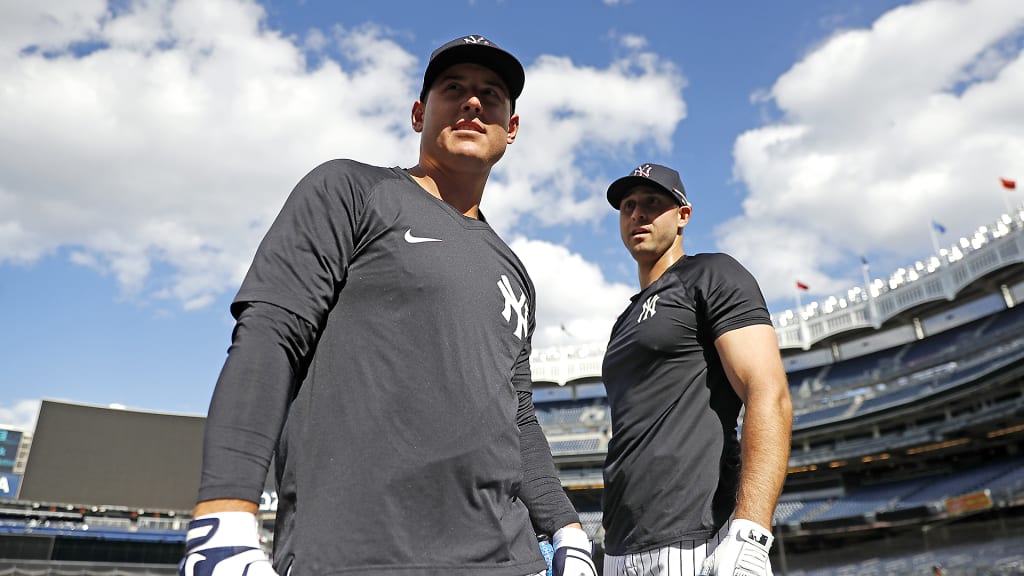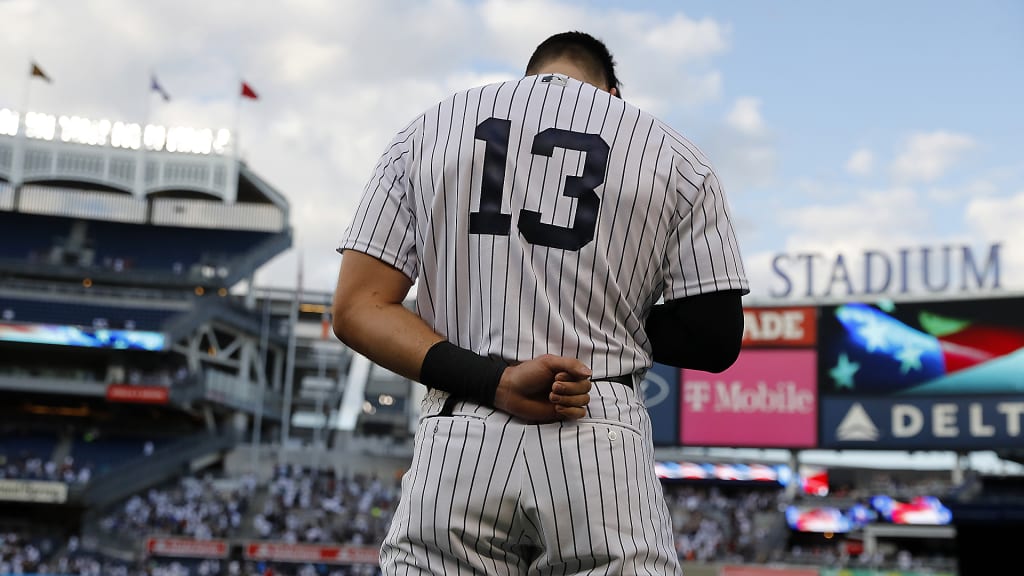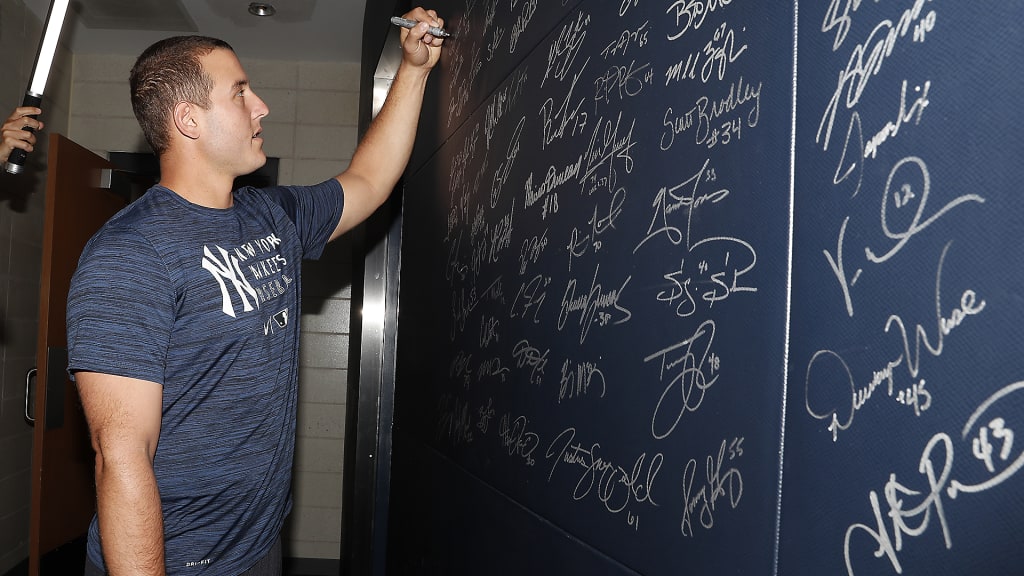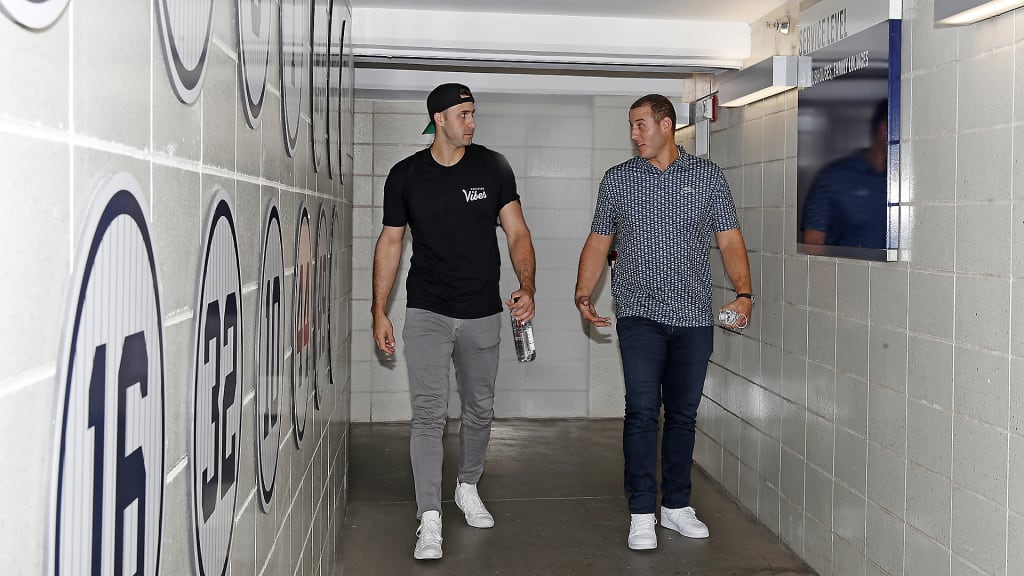
It was the worst of times, it was the hold-my-beer-it-can-get-even-worse of times. The first four months of the 2021 season had been a roller-coaster, which means they were at least better than the irredeemable year outside the ballpark. But it was hardly a start worth celebrating.
The Yankees headed to Fenway Park in late July teetering on an edge befitting an Olympic gymnast. The team was looking up at the Red Sox (and the Rays) in the standings, but generally playing better baseball than it had in the first half. Four games in Boston offered an opportunity to rewrite the narrative. Instead, disaster. The Red Sox took three of four, two of the wins in dramatic, late-inning comeback fashion, the other in a game started by Yankees ace Gerrit Cole.
With the clock ticking toward the Trade Deadline and the team reeling from what manager Aaron Boone called a “gut punch,” the Yankees sat nine games out of first in the American League East and 3 1/2 out of Wild Card position.
The table turned its eyes to Brian Cashman, as the Yankees’ general manager stared down at his hole cards. Fold or raise? This was no time to be passive.
“There’s no question that we’re in this,” Cashman said shortly after the Deadline, explaining his thought process. “And so, what are we going to do about it? Are we going to sit back and just let it play out with what I think is an extremely talented roster? Or do we acknowledge that it’s not good enough, despite the talent, and it needs more?”
By 4 p.m. on July 30, Cashman had pushed his chips into the pot, emerging from the hand with two much-needed left-handed bats in Joey Gallo and Anthony Rizzo, along with pitchers Andrew Heaney, Clay Holmes and Joely Rodríguez.
Wisdom, foolishness. Belief, incredulity. Light and darkness, hope and despair ... Charles Dickens would have loved this team. “Death may beget life,” et cetera, et cetera? Fortunately, baseball games don’t play with those stakes (despite the protestations of talk radio callers). But as the Yankees charged into August and beyond, buoyed both physically and emotionally, there remained the undying hope that 2021 might become a tale of two seasons.
***
When it opened in 1923, The House That Ruth Built was essentially a house built for Ruth. That right-field corner, originally measuring just about 295 feet down the line, was an immeasurable gift. The Bambino would have been a legend anywhere (indeed, he already was one), but the Yankee Stadium dimensions provided ample opportunity to add to his ledger.
And why mess with a winning strategy? Over the years, Yankees lineups have been fortified by lefties or switch-hitters who earned headlines (and money) by taking dead aim at the short porch in right. Yogi, Mickey, Roger and Reggie just picked up what Ruth and Gehrig had started. Since 1923, Yankees left-handers have homered every 24.3 at-bats at home; righties have seen that mark drop all the way down to 42.3.
Yet the 2021 Yankees were built on the strength of right-handed power. Granted, righties have an easier time at the current incarnation of the ballpark than those of Ruth’s era, and any team would love to have its biggest problem be too many hitters such as Giancarlo Stanton, Aaron Judge, DJ LeMahieu and Gary Sánchez wedged into a lineup. But over the first half, that short porch was just sitting there, beckoning.
“I don’t think it’s been a secret that the left-handed bats were missing,” says Rizzo, who was acquired from the Cubs in exchange for two Minor Leaguers, center fielder Kevin Alcantara and right-hander Alexander Vizcaino. “From afar looking in, you always knew that.”
Cashman knew it, too. He spent a good amount of time this past spring trying to pry Gallo from the Rangers, with whom the Nevada native had played his entire career. An elite defensive outfielder with awesome athleticism and satellite-threatening power from the left side -- to say nothing of the fact that he doesn’t become a free agent until after the 2022 season -- Gallo made a ton of sense in pinstripes.
“I thought we were close in Spring Training,” Cashman said of his protracted negotiations with Texas, which eventually sent Gallo to the Yankees for four prospects. “We always thought that he would fit really well here at Yankee Stadium: very athletic, can play a lot of different positions, left-handed bat that could give us balance.”

Gallo’s hardly a wall-scraper; through Aug. 10, 17 of his 26 homers this year classified as “no-doubters” according to the Statcast data on baseballsavant.com. But those same numbers showed another key detail: Put Gallo in Yankee Stadium, and that 26 figure would have been 30, the highest adjusted total for his profile in any big-league park. As potential marriages go, this was kismet.
“You watch those games growing up,” Gallo says, “and guys hitting balls out to right field and that short porch. It should be fun.”
The homers scream from the box score, overshadowing some of the complexities of Gallo’s approach. He is a real three-true-outcomes hitter -- homers, walks, strikeouts, the last stat piling up in a fashion that can be, on the surface, unseemly.
“I know what I can and cannot do,” Gallo says. “I know I’m going to strike out a lot. But I know I have power, and I have to use it when I can. I know I have to have good at-bats and be able to take walks and swing at strikes. So I think, for me, learning myself, knowing, ‘OK, I’m not going to hit for a high average, but if I walk a lot, that might balance out the fact that I don’t hit for a high average. If I hit for power, that might balance out the fact that I don’t hit .300.’”
And Gallo is a process-driven player who knows that showy success can sometimes overshadow quiet progress. Those nine-pitch strikeouts might end ugly, but he’s seeing pitches, his teammates are getting looks, the pitcher is being made to work.
Nothing in baseball exists on its own pedestal. Gallo doesn’t chase bad pitches. He walks a ton. And when he connects, it’s majestic.
“Sign me up for the guy that’s on base almost 40% of the time and has the kind of power and provides the kind of potential balance for our lineup,” a gleeful Boone said when asked if the strikeouts concerned him. “No player is perfect, but it’s hard to argue that we’re not a lot better team adding Joey Gallo.”
***
Boone couldn’t help but admire Gallo when the Yankees were in Texas earlier this year. Despite taking home the AL Gold Glove Award for right field last season, Gallo was still mainly judged by his offensive stats. The games against the Rangers were an awakening for the Yankees’ manager.
“To see him run,” Boone says, “to see him move in the outfield, to see him throw, you really took notice of it. He really kind of jumps off the screen at you with how physically impressive he is with his athleticism.”
With Rizzo, the package sneaks up on you less. Unlike Gallo, Rizzo’s defense plays out in the classic, exceptional style for elite first basemen. He is not fast. His numbers require less context. Rizzo’s Baseball Reference page is dotted with MVP votes, Gold Gloves, All-Star selections and more, and while he doesn’t have Gallo’s 40-homer seasons, he does have that 2016 World Series championship with the Cubs.
“Every time he comes up to the plate, you expect something to happen, for him to have a good at-bat, at least,” Gallo says of Rizzo. “That’s all you can really expect out of a guy: A platinum defender who has great at-bats every time he steps up to the plate.”

Rizzo came to town and immediately started showing off. He had an RBI in each of his first six games, the first Yankees player to accomplish that since at least 1920, when RBI became an official statistic. While Gallo was still finding his comfort zone in his first few weeks with the team, Rizzo made the dream first impression. And in doing so, Rizzo (and Gallo) demonstrated some perhaps unintended but nevertheless important wisdom on Cashman’s part. A lineup that features the Yankees’ veteran bats probably doesn’t need a “hero,” per se, but there’s no doubt that by bringing in the two stars together, neither would have to shoulder the entire load.
“I definitely think it helps both of us,” Rizzo says. “Whenever you go in anywhere and they tout you as being something, that could be tricky. ... But I think just with Joey and myself, you have two professional bats coming up, grinding at-bats, really helping this lineup balance out.”
Like so many members of that 2016 Cubs team, the stars of which have now almost all been shipped out of Chicago, Rizzo was beloved in the clubhouse and out, one of the most popular players in recent Cubs history. Immediately, he stepped into a leadership role in New York, quietly but confidently asserting himself.
“I think when I rely on all my track record in the past and all my experiences, it makes me able to just come in and be me,” Rizzo says. “And being me has gotten me to this place. So, I’m not going to change, and I’ll tell myself not to try to be anyone else.”
That confidence showed as soon as Rizzo addressed his fellow infielders with a simple directive: Just throw it; I’ll catch it. He said in his introductory press conference that his favorite thing about playing first base was when he would watch a third baseman dive to his right to make a play, then do anything possible to catch the throw across the diamond. Sure enough, that very night, Tyler Wade -- filling in at the hot corner for Gio Urshela -- made a remarkable play diving toward the foul line, and Rizzo picked the throw easily.
“You do that enough for them,” Rizzo says, “the next thing you know, those balls aren’t in the dirt anymore, they’re in your chest. Because they’re just so comfortable that they can just throw it. And the more relaxedall of us are, the better.”
“He’s one of those guys that every time an infielder makes a throw, I’m just relaxed,” Gallo says. “Because I know it’s somehow going to get caught. You’re not always like that with all first basemen. And I can see throws from left coming in, I’m like, ‘Ooh, that’s off target.’ And then I’m like, ‘Oh, it’s all right, Rizzo is there.’”
***
Forgive Gallo, because it’s not the only time that he finds himself doing a double-take these days. Despite growing up out West, Gallo’s parents are from Brooklyn, and he grew up rooting for the Yankees, idolizing Derek Jeter. But when baseball becomes a job, allegiances go out the window. At least temporarily.
“When you’re not playing for the Yankees, or you’re not a Yankees fan, you’re always rooting against the Yankees. That’s just how it goes,” Gallo says. “So now it’s kind of cool to see the Yankees on ESPN or something, and I’m like, ‘Oh yeah, I’m on that team now. Sick! Yeah, the Yankees are winning!’ You almost forget, just because it’s been ingrained in your memory for so long. It’s cool that I’m actually able to come back to my roots a little bit and be a Yankees fan.”
Gallo grew up in batting cages, modeling swings after each hitter in the Yankees lineup; his first Yankee Stadium “roll call” was a dream come true.
The Florida-raised Rizzo also grew up a Yankees fan, spending his summers on the Jersey Shore. As emotional as he was about leaving Chicago, where he had built such a devoted following and planted roots, he cherished the opportunity to put on the pinstripes. He said that he needed 50 tickets for his first home game in the Bronx, and whatever fidelity he did or did not maintain as a lapsed Yankees fan playing in Chicago, he was particularly thrilled for family members who would no longer need to hedge.
“I know my aunts and uncles would always play cards and watch the Cubs games, knowing they’re all die-hard Yankees fans, as well,” Rizzo says, laughing. “And then now, I just picture them playing cards and watching the Yankees game, how cool that is for them. How cool it is for my parents, for me, the little kid in me. It’s amazing.”
But there are few straight lines in a lifetime, and fewer yet in baseball. After just nine games with the Yankees, Rizzo had to step aside for a spell due to COVID-19. All the while, Gallo had a single homer (albeit a timely one) in his first 14 games. But the Yankees were winning. Of equal importance in terms of the postseason race, the Red Sox were losing.
The weeks after that series in Boston feltlike a year, with the baseball landscape changing dramatically. The Trade Deadline was a wild scramble, as nearly every team in contention found ways to improve. Judge, always the surest agent of Yankees exceptionalism, played the whole thing off as a no-brainer.
“We’re the Yankees,” the All-Star right fielder said after the dust had settled. “This is what we do. I had no doubt in my mind that we were going to make some moves or do something. We’re always in it. It doesn’t matter how many games back we are, there are still a lot of games left to be played.”
In Gallo and Rizzo, the Yankees added elite players while also addressing obvious needs. The team’s defense improved, its athleticism got better, and the matchups got tougher. (It also gave Boone the chance to roll out an outfield of the 6-foot-5 Gallo in right, 6-foot-7 Judge in center and the 6-foot-6 Stanton in left, with Gallo playfully bemoaning the fact that his too-tall teammates somehow left him as the “skinny, weak guy.”)
“It just kind of adds a diversity,” Judge said. “Instead of just rolling out their best right-handed pitchers through the whole lineup, teams are going to have to make choices here on what they want to do.”
That’s the tangible impact, and it’s huge; no one would know that better than Judge. But the additions had another benefit: In the weeks after the trades, there was a palpable energy, with the Yankees fighting back to win one game after another. Whether the new additions were contributing to the box score or not, there was a fire that had been lit.

“I know we’re better today than we were yesterday,” Cashman said upon announcing the moves, and he and Yankees managing general partner Hal Steinbrenner deserve credit for seeing a team at what -- from the outside -- appeared as close to its nadir as possible, and recognizing what a few imports could do.
But if you felt like you saw something ethereal playing out as August rolled on, you weren’t alone. At a time when some teams might have folded their cards, Cashman stayed in the hand. Maybe Gallo and Rizzo will be the final pieces to a championship puzzle, or maybe the biggest difference-maker down the stretch will end up being one of the less-heralded pitchers immediately pressed into service to relieve a staff beset by injuries. Baseball is unpredictable, as any Yankees fan has heard on the radio.
If the inspirational value of belief feels too stolen from a Ted Lasso script for your taste, so it goes. But rest assured, the players took notice.
“I remember hearing a guy say that it made them feel really good and energized at the Deadline,” Gallo said. “They went forward and believed in them instead of getting rid of guys.
“When you get rid of guys, it’s a tough feeling. I’ve been a part of that. When you add guys, it’s a great feeling: ‘OK, they believe in us.’ And I know guys felt like that. When they added guys at the Deadline, they were like, ‘Oh wow, the front office believes in us.’ And it gives you a little boost, for sure. So, it’s exciting that we’re going to be a part of it.”
Forget Charles Dickens; we’re into Frank Sinatra territory now. Two Yankees fans, brought in to save the day. The task: Just make a brand new start of it.